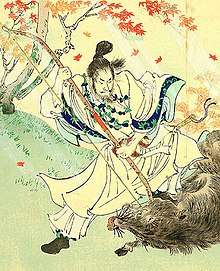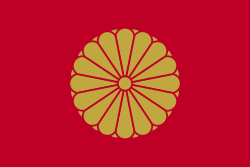Emperor Yūryaku
Emperor Yūryaku (雄略天皇, Yūryaku-tennō) was the 21st Emperor of Japan,[2] according to the traditional order of succession.[3] He is remembered as a patron of sericulture.[4]
| Yūryaku | |
|---|---|
 | |
| Emperor of Japan | |
| Reign | 456–479 (traditional)[1] |
| Predecessor | Ankō |
| Successor | Seinei |
| Born | 418 |
| Died | 479 (aged 60–61) Hatsuse no Asakura Palace |
| Burial | Tajihi no Takawashi-no-hara no misasagi (丹比高鷲原陵) (Habikino, Osaka) |
| Spouse | |
| Issue | See below |
| Father | Emperor Ingyō |
| Mother | Empress Oshisaka no Ōnakatsuhime |
| Religion | Shinto |
No firm dates can be assigned to this Emperor's life or reign, but he is conventionally considered to have reigned from 456 to 479.[5]
Legendary narrative
Yūryaku was a 5th-century monarch.[6] The reign of Emperor Kinmei (c. 509 – 571 AD), the 29th Emperor,[7] is the first for which contemporary historiography is able to assign verifiable dates;[8] however, the conventionally accepted names and dates of the early Emperors were not to be confirmed as "traditional" until the reign of Emperor Kanmu (737–806), the 50th sovereign of the Yamato dynasty.[9]
According to the Kojiki, this Emperor is said to have ruled from the Thirteenth Day of the Eleventh Month of 456 (Heishin) until his death on the Seventh Day of the Eight Month of 479 (Kibi).
According to Kojiki and Nihon Shoki, Yūryaku was named Prince Ōhatsuse Wakatake (大泊瀬幼武) at birth. Yūryaku is a name posthumously assigned to him by a much later era. He was the fifth and youngest son of Emperor Ingyō. After his elder brother Emperor Ankō was murdered, he won the struggle against his other brothers and became the new Emperor.
Yūryaku's contemporary title would not have been tennō, as most historians believe this title was not introduced until the reigns of Emperor Tenmu and Empress Jitō. Rather, it was presumably Sumeramikoto or Amenoshita Shiroshimesu Ōkimi (治天下大王), meaning "the great king who rules all under heaven". Alternatively, Hanzei might have been referred to as ヤマト大王/大君 or the "Great King of Yamato". He had three wives (including his consort Kusahahatahi). His successor, Prince Shiraka (Emperor Seinei), was his son by his wife Kazuraki no Karahime.
In 463, Yūryaku Tennō invited the thunder god of the Mimuro hill to come to the Imperial Palace, and ordered Chiisakobe no muraji Sugaru to fetch the deity. He obliged, thinking the supernatural being would have no reason to refuse the invitation, and rode carrying a halberd with a red banner, symbolising his office of royal messenger. Soon enough, the thunder stroke, and Sugaru enlisted the help of priests to enshrine the kami into a portable carriage, to be brought in the Emperor's presence, as a great serpent. But, said Emperor neglected to practice proper ritual purification and religious abstinence. The thunder kami then showed his displeasure through thundering and threatening fiery eyeballs, and Emperor Yūryaku fled into the interior of the Palace while covering his eyes. The great serpent was returned to Mimuro, and the Emperor made many offerings to appease the angry deity. This story is recorded in Nihongi and mentioned by William George Aston, in "Shinto, the Ancient Religion of Japan" as well as several other books.
According to the Nihongi, Yūryaku was of ungovernable and suspicious temperament, and committed many acts of arbitrary cruelty.
The actual site of Yūryaku's grave is not known.[2] The Emperor is traditionally venerated at a memorial Shinto shrine (misasagi) in Habikino, Osaka, which is designated by the Imperial Household Agency as Yūryaku's mausoleum. It is formally named Tajihi no Takawashi-no-hara no misasagi.[10]
Consorts and children
Empress: Princess Kusaka-no-hatabihime (草香幡梭姫皇女), Emperor Nintoku's daughter
Consort: Katsuragi no Karahime (葛城韓媛), Katsuragi no Tsubura no Ōomi's daughter
- Third Son: Prince Shiraka (白髪皇子), later Emperor Seinei
- Princess Takuhatahime (栲幡姫皇女, d.459), Saiō
Consort: Kibi no Wakahime (吉備稚媛, d.479), Kibi no Kamitsumichi no omi's daughter
- Prince Iwaki (磐城皇子, d.479/81)
- Prince Hoshikawa no Wakamiya (星川稚宮皇子, d.479)
Consort: Wani no ominagimi (和珥童女君), Kasuga no Wani no omi Fukame's daughter
- Princess Kasuga no Ōiratsume (春日大娘皇女), married to Emperor Ninken
King Bu
According to the Book of Song, a King Bu (武) from Japan dispatched envoys to the Emperor of Liu Song, a minor Chinese dynasty, in both 477 and 478. Communications included a notice that the previous ruler, an older brother, had died, and that Bu had ascended to the throne.[11] The King 'Bu' in this document is believed to refer to Emperor Yūryaku, due to the fact that the character used to write the name (武) is found in the name by which Emperor Yūryaku was called during his lifetime: Ōhatsuse Wakatakeru no Mikoto (大泊瀬幼武尊).
The inscriptions on the Inariyama and Eta Funayama Sword, also supports the idea that Bu is an equivalent of Emperor Yūryaku.
The Chinese historical records state that Bu began his rule before 477, was recognized as the ruler of Japan by the Liu Song, Southern Qi, and Liang dynasties, and continued his rule through to 502.
Poetry
The Emperor's interest in poetry is amongst the more well-documented aspects of his character and reign. Poems attributed to him are included in the Man'yōshū, and a number of his verses are preserved in the Kojiki and the Nihonshoki.[4]
See also
- Emperor of Japan
- List of Emperors of Japan
- Eta Funayama Sword
- Five kings of Wa
- Imperial cult
- Inariyama Sword
Notes
- "Genealogy of the Emperors of Japan" at Kunaicho.go.jp; retrieved 2013-8-28.
- Imperial Household Agency (Kunaichō): 雄略天皇 (21); retrieved 2013-8-28.
- Titsingh, Isaac. (1834). Annales des empereurs du japon, pp. 27–28; Brown, Delmer M. (1979). Gukanshō, p. 258; Varley, H. Paul. (1980). Jinnō Shōtōki, pp. 113–115.
- Nippon Gakujutsu Shinkokai (1969). The Manyōshū, p. 317.
- Ponsonby-Fane, Richard. (1959). The Imperial House of Japan, p. 40.
- Kelly, Charles F. "Kofun Culture," Japanese Archaeology. 27 April 2009.
- Titsingh, pp. 34–36; Brown, pp. 261–262; Varley, pp. 123–124.
- Hoye, Timothy. (1999). Japanese Politics: Fixed and Floating Worlds, p. 78; excerpt, "According to legend, the first Japanese Emperor was Jinmu. Along with the next 13 Emperors, Jinmu is not considered an actual, historical figure. Historically verifiable Emperors of Japan date from the early sixth century with Kinmei.
- Aston, William. (1896). Nihongi, pp. 109.
- Ponsonby-Fane, p. 419.
- Batten, Bruce Loyd. (2006). Gateway to Japan, pp. 17–18. at Google Books
References
- Aston, William George. (1896). Nihongi: Chronicles of Japan from the Earliest Times to A.D. 697. London: Kegan Paul, Trench, Trubner. OCLC 448337491
- Batten, Bruce Loyd. (2006). Gateway to Japan: Hakata in war and peace, 500–1300. Honolulu:University of Hawaii Press. ISBN 978-0-8248-2971-1; ISBN 978-0-8248-3029-8; OCLC 254764602]
- Brown, Delmer M. and Ichirō Ishida, eds. (1979). Gukanshō: The Future and the Past. Berkeley: University of California Press. ISBN 978-0-520-03460-0; OCLC 251325323
- Nippon Gakujutsu Shinkokai (1969). The Manyōshū: The Nippon Gakujutsu Shinkokai Translation of One Thousand Poems. New York: Columbia University Press. ISBN 0-231-08620-2
- Ponsonby-Fane, Richard Arthur Brabazon. (1959). The Imperial House of Japan. Kyoto: Ponsonby Memorial Society. OCLC 194887
- Titsingh, Isaac. (1834). Nihon Ōdai Ichiran; ou, Annales des empereurs du Japon. Paris: Royal Asiatic Society, Oriental Translation Fund of Great Britain and Ireland. OCLC 5850691
- Varley, H. Paul. (1980). Jinnō Shōtōki: A Chronicle of Gods and Sovereigns. New York: Columbia University Press. ISBN 978-0-231-04940-5; OCLC 59145842
External links
- Nihon Shoki Online English Translations. Scroll 14 - Emperor Yuryaku
| Regnal titles | ||
|---|---|---|
| Preceded by Emperor Ankō |
Emperor of Japan: Yūryaku 456–479 (traditional dates) |
Succeeded by Emperor Seinei |
